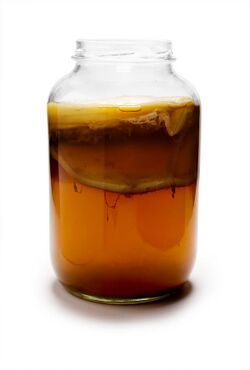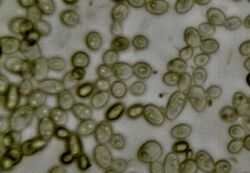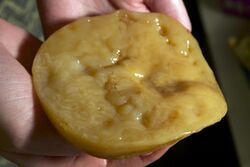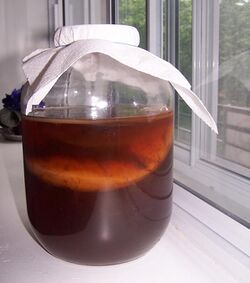Biology:Kombucha
 Kombucha tea, including the culture of bacteria and yeast, which is not usually consumed | |
| Type | Flavored cold tea drink with fermentation byproducts |
|---|---|
| Country of origin | China |
| Alcohol by volume | <0.5% (commercial) |
| Proof (US) | <1 (commercial) |
| Color | Cloudy, commonly pale or dark brown and sometimes green |
| Flavor | Fermented, effervescent |
| Ingredients | Tea, sugar, bacteria, yeast |
| Variants | Fruit juices or spices added |
| Related products | Water kefir, kefir, kvass, beer, iced tea |
| This article is part of a series on |
| Alternative and pseudo‑medicine |
|---|
 |
Kombucha (also tea mushroom, tea fungus, or Manchurian mushroom when referring to the culture; Latin name Medusomyces gisevii)[1] is a fermented, lightly effervescent, sweetened black tea drink. Sometimes the beverage is called kombucha tea to distinguish it from the culture of bacteria and yeast.[2] Juice, spices, fruit or other flavorings are often added.
Kombucha is thought to have originated in China , where the drink is traditional.[3][4] By the early 20th century it spread to Russia, then other parts of Eastern Europe and Germany.[5] Kombucha is now homebrewed globally, and also bottled and sold commercially.[1] The global kombucha market was worth approximately US$1.7 billion (As of 2019).[6]
Kombucha is produced by symbiotic fermentation of sugared tea using a symbiotic culture of bacteria and yeast (SCOBY) commonly called a "mother" or "mushroom". The microbial populations in a SCOBY vary. The yeast component generally includes Saccharomyces cerevisiae, along with other species; the bacterial component almost always includes Gluconacetobacter xylinus to oxidize yeast-produced alcohols to acetic acid (and other acids).[7] Although the SCOBY is commonly called "tea fungus" or "mushroom", it is actually "a symbiotic growth of acetic acid bacteria and osmophilic yeast species in a zoogleal mat [biofilm]".[1] The living bacteria are said to be probiotic, one of the reasons for the popularity of the drink.[8][9]
Numerous health benefits have been claimed to correlate with drinking kombucha;[10] there is little evidence to support any of these claims.[8][10][11] The beverage has caused rare serious adverse effects, possibly arising from contamination during home preparation.[12][13] It is not recommended for therapeutic purposes.[10][14]
History
Kombucha most likely originated in the Bohai Sea district in China .[4] The drink was consumed in Russia and from there entered the rest of Europe.[15] Its consumption increased in the United States during the early 21st century.[16][17] Having an alcohol content of less than 0.5%, kombucha is not a federally regulated beverage in the United States.[18][19]
Prior to 2015, some commercially available kombucha brands were found to contain alcohol content exceeding this threshold, sparking the development of new testing methods.[20] With rising popularity in developed countries in the early 21st century, kombucha sales increased after it was marketed as an alternative to beer and other alcoholic drinks in restaurants and pubs.[21]
According to the market research firm Grand View Research,[clarification needed] kombucha had a global market size of US$1.67 billion, (As of 2019) and this is expected to grow to US$9.7 billion by 2030.[6]
Etymology and terminology
In Japanese, the term konbu-cha (昆布茶, 'kelp tea') refers to a kelp tea made with powdered konbu (an edible kelp from the family Laminariaceae) and is a completely different beverage from the fermented tea usually associated with kombucha elsewhere in the world.[citation needed]
The etymology of kombucha is uncertain; however, it is speculated that it is a misapplied loanword from Japanese.[22] It has been hypothesized that English speakers mistook the Japanese word kombucha to mean fermented tea, when in fact, fermented tea in Japanese is called kōcha kinoko (紅茶キノコ, 'red tea mushroom').[23] Webster's Dictionary says the use of kombucha in English likely stems from the misapplication of Japanese words: kombucha, kobucha 'tea made from kelp', kobu, konbu 'kelp', and cha 'tea'.[24] The American Heritage Dictionary states that it was "perhaps ... used by English speakers to designate fermented tea due to confusion or because the thick gelatinous film produced by the kombucha culture was thought to resemble seaweed."[25]
The first known use in the English language of the word to describe "a gelatinous mass of symbiotic bacteria (as Acetobacter xylinum) and yeasts (as of the genera Brettanomyces and Saccharomyces) grown to produce a fermented beverage held to confer health benefits" was in 1944.[24]
Composition and properties
Biological
A kombucha culture is a symbiotic culture of bacteria and yeast (SCOBY), similar to mother of vinegar, containing one or more species each of bacteria and yeasts, which form a zoogleal mat[26] known as a "mother".[1] There is a broad spectrum of yeast species spanning several genera reported to be present in kombucha culture including species of Zygosaccharomyces, Candida, Kloeckera/Hanseniaspora, Torulaspora, Pichia, Brettanomyces/Dekkera, Saccharomyces, Lachancea, Saccharomycoides, Schizosaccharomyces, Kluyveromyces, Starmera, Eremothecium, Merimbla, Sugiyamaella.[27][28][29]
The bacterial component of kombucha comprises several species, almost always including the acetic acid bacteria Komagataeibacter xylinus (formerly Gluconacetobacter xylinus), which ferments alcohols produced by the yeasts into acetic and other acids, increasing the acidity and limiting ethanol content.[30][citation needed] The population of bacteria and yeasts found to produce acetic acid has been reported to increase for the first 4 days of fermentation, decreasing thereafter.[31] K. xylinus produces bacterial cellulose, and is reportedly responsible for most or all of the physical structure of the "mother", which may have been selectively encouraged over time for firmer (denser) and more robust cultures by brewers.[32][non-primary source needed] The highest diversity of Kombucha bacteria was found to be on the 7th day of fermentation with the diversity being less in the SCOBY. Acetobacteraceae dominate 88 percent of the bacterial community of the SCOBY.[29] The acetic acid bacteria in kombucha are aerobic, meaning that they require oxygen for their growth and activity.[27] Hence, the bacteria initially migrate and assemble at the air interface, followed by excretion of bacterial cellulose after about 2 days.[33]
The mixed, presumably mutualistic culture has been further described as being lichenous, in accord with the reported presence of the known lichenous natural product usnic acid, though as of 2015, no report appears indicating the standard cyanobacterial species of lichens in association with kombucha fungal components.[34]
Chemical composition
Kombucha is made by adding the kombucha culture into a broth of sugared tea.[1] The sugar serves as a nutrient for the SCOBY that allows for bacterial growth in the tea.[35] Sucrose is converted, biochemically, into fructose and glucose, and these into gluconic acid and acetic acid.[15] In addition, kombucha contains enzymes and amino acids, polyphenols, and various other organic acids which vary between preparations. Other specific components include ethanol (see below), glucuronic acid, glycerol, lactic acid, usnic acid (a hepatotoxin, see above), and B-vitamins.[36][37][38] Kombucha has also been found to contain vitamin C.[39]
The alcohol content of kombucha is usually less than 0.5%, but increases with extended fermentation times.[40] The concentration of alcohol specifically ethanol increases initially but then begins to decrease when acetic acid bacteria utilize it to produce acetic acid.[29] Over-fermentation generates high amounts of acids similar to vinegar.[1] The pH of the drink is typically about 3.5.[10]
Production
Kombucha can be prepared at home or commercially.[1] It is made by dissolving sugar in non-chlorinated boiling water. Tea leaves are steeped in the hot sugar water and discarded. The sweetened tea is cooled and the SCOBY culture is added. The mixture is then poured into a sterilized beaker along with previously fermented kombucha tea to lower the pH, this technique is known as "backslopping".[41] The container is covered with a paper towel or breathable fabric to prevent insects such as fruit flies from contaminating the kombucha.
The tea is left to ferment for a period of up to 10 to 14 days at room temperature (18°C to 26°C). A new "daughter" SCOBY will form on the surface of the tea to the diameter of the container. After fermentation is completed, the SCOBY is removed and stored along with a small amount of the newly fermented tea. The remaining kombucha is strained and bottled for a secondary ferment for a few days or stored at a temperature of 4 °C.[1]
Commercially bottled kombucha became available in the late 1990s.[42] In 2010, elevated alcohol levels were found in many bottled kombucha products, leading retailers including Whole Foods to temporarily pull the drinks from store shelves.[43] In response, kombucha suppliers reformulated their products to have lower alcohol levels.[44]
By 2014, US sales of bottled kombucha were $400 million, $350 million of which was earned by Millennium Products, Inc. which sells GT's Kombucha.[45] In 2014, the companies that make and sell kombucha formed a trade organization, Kombucha Brewers International.[46] In 2016, PepsiCo purchased kombucha maker KeVita for approximately $200 million.[47] In the US, sales of kombucha and other fermented drinks rose by 37 percent in 2017.[21] Beer companies like Full Sail Brewing Company and Molson Coors Beverage Company produce kombucha by themselves or via subsidiaries.[48]
As of 2021, the drink had some popularity in India's National Capital Region, partly due to its success in the west.[49]
Hard kombucha
Some commercial kombucha producers sell what they call "hard kombucha" with an alcohol content of over 5 percent.[48][50]
Health claims
Kombucha is promoted with many claims for health benefits, from alleviating hemorrhoids to combatting cancer.[51] Although people may drink kombucha for such supposed health effects[which?], there is no clinical proof that it provides any benefit.[1][8][52][53] In a 2003 review, physician Edzard Ernst characterized kombucha as an "extreme example" of an unconventional remedy because of the disparity between implausible, wide-ranging health claims and the potential risks of the product.[10] It concluded that the proposed, unsubstantiated therapeutic claims did not outweigh known risks, and that kombucha should not be recommended for therapeutic use, being in a class of "remedies that only seem to benefit those who sell them".[10]
Adverse effects
Reports of adverse effects related to kombucha consumption are rare, but may be underreported, according to a 2003 review.[10] The American Cancer Society said in 2009 that "serious side effects and occasional deaths have been associated with drinking Kombucha tea."[13] Because kombucha is a commonly homemade fermentation, caution should be taken because pathogenic microorganisms can contaminate the tea during preparation.[14][27]
Adverse effects associated with kombucha consumption may include severe hepatic (liver) and renal (kidney) toxicity as well as metabolic acidosis.[54][55][56]
Some adverse health effects may arise from the acidity of the tea causing acidosis, and brewers are cautioned to avoid over-fermentation.[12][57][40] Other adverse effects may be a result of bacterial or fungal contamination during the brewing process.[40] Some studies have found the hepatotoxin usnic acid in kombucha, although it is not known whether the cases of liver damage are due to usnic acid or to some other toxin.[55][34]
Drinking kombucha can be harmful for people with preexisting ailments.[58] Due to its microbial sourcing and possible non-sterile packaging, kombucha is not recommended for people with poor immune function,[12] women who are pregnant or nursing, or children under 4 years old:[40] It may compromise immune responses or stomach acidity in these susceptible populations.[12] There are certain drugs that one should not take with kombucha because of the small percentage of alcohol content.[59]
A 2019 review enumerated numerous potential health risks[which?], but said "kombucha is not considered harmful if about 4 oz [120 mL] per day is consumed by healthy individuals; potential risks are associated with a low pH brew leaching heavy metals from containers, excessive consumption of highly acidic kombucha, or consumption by individuals with pre-existing health conditions."[53]
Other uses
Kombucha culture, when dried, becomes a leather-like textile known as a microbial cellulose that can be molded onto forms to create seamless clothing.[60][61] Using different broth media such as coffee, black tea, and green tea to grow the kombucha culture results in different textile colors, although the textile can also be dyed using other plant-based dyes.[62] Different growth media and dyes also change the textile's feel and texture.[62] Additionally the SCOBY itself can be dried and eaten as a sweet or savory snack.[63]
See also
- Enviga – A carbonated green tea drink promoted with bogus health claims
- Jun, a fermented drink made from green tea and honey
- Kefir, a fermented dairy product
- Kvass, a traditional fermented drink made from bread
- List of unproven or disproven cancer treatments
- Tibicos, or "water kefir"
References
- ↑ 1.0 1.1 1.2 1.3 1.4 1.5 1.6 1.7 1.8 Jayabalan, Rasu (21 June 2014). "A Review on Kombucha Tea—Microbiology, Composition, Fermentation, Beneficial Effects, Toxicity, and Tea Fungus". Comprehensive Reviews in Food Science and Food Safety 13 (4): 538–550. doi:10.1111/1541-4337.12073. PMID 33412713.
- ↑ "A mug of kombucha for your health?". Mayo Clinic. https://www.mayoclinic.org/healthy-lifestyle/consumer-health/expert-answers/kombucha-tea/faq-20058126.
- ↑ "kombucha | Description, History, & Nutrition" (in en). https://www.britannica.com/topic/kombucha.
- ↑ 4.0 4.1 Alex., LaGory (2016). The Big Book of Kombucha. Storey Publishing, LLC. pp. 251. ISBN 978-1-61212-435-3. OCLC 1051088525. http://worldcat.org/oclc/1051088525.
- ↑ Troitino, Christina. "Kombucha 101: Demystifying The Past, Present And Future Of The Fermented Tea Drink". Forbes. https://www.forbes.com/sites/christinatroitino/2017/02/01/kombucha-101-demystifying-the-past-present-and-future-of-the-fermented-tea-drink/.
- ↑ 6.0 6.1 "Kombucha Market Size, Share & Trends Analysis Report By Flavor (Original, Flavored), By Distribution Channel (Supermarkets, Health Stores, Online Stores), By Region, And Segment Forecasts, 2020 - 2027". Grandview Research. February 2020. https://www.grandviewresearch.com/industry-analysis/kombucha-market.
- ↑ Jonas, Rainer; Farah, Luiz F. (1998). "Production and application of microbial cellulose". Polymer Degradation and Stability 59 (1–3): 101–106. doi:10.1016/s0141-3910(97)00197-3.
- ↑ 8.0 8.1 8.2 Bauer, Brent (8 July 2017). "What is kombucha tea? Does it have any health benefits?". Mayo Clinic. https://www.mayoclinic.org/healthy-lifestyle/consumer-health/expert-answers/kombucha-tea/faq-20058126.
- ↑ Wollan, Malia (24 March 2010). "Kombucha Tea Attracts a Following and Doubters". The New York Times. https://www.nytimes.com/2010/03/25/fashion/25Tea.html.
- ↑ 10.0 10.1 10.2 10.3 10.4 10.5 10.6 Ernst E (2003). "Kombucha: a systematic review of the clinical evidence". Forschende Komplementärmedizin und Klassische Naturheilkunde 10 (2): 85–87. doi:10.1159/000071667. PMID 12808367. https://www.ncbi.nlm.nih.gov/pubmedhealth/PMH0020339/.
- ↑ Kapp, J. M.; Sumner, W. (2019). "Kombucha: a systematic review of the empirical evidence of human health benefit". Annals of Epidemiology (Elsevier) 30: 66–70. doi:10.1016/j.annepidem.2018.11.001. PMID 30527803.
- ↑ 12.0 12.1 12.2 12.3 "Kombucha". Memorial Sloan Kettering Cancer Center. 22 May 2014. https://www.mskcc.org/cancer-care/integrative-medicine/herbs/kombucha.
- ↑ 13.0 13.1 "Kombucha tea". American Cancer Society Complete Guide to Complementary and Alternative Cancer Therapies (2nd ed.). New York: American Cancer Society. 2009. pp. 629–633. ISBN 9780944235713. https://archive.org/details/americancancerso0000unse. "Serious side effects and occasional deaths have been associated with drinking Kombucha tea"
- ↑ 14.0 14.1 Bauer, Brent. "What is kombucha tea? Does it have any health benefits?". https://www.mayoclinic.org/healthy-lifestyle/consumer-health/expert-answers/kombucha-tea/faq-20058126.
- ↑ 15.0 15.1 Sreeramulu, G; Zhu, Y; Knol, W (2000). "Kombucha fermentation and its antimicrobial activity". Journal of Agricultural and Food Chemistry 48 (6): 2589–2594. doi:10.1021/jf991333m. PMID 10888589. https://research.kombuchabrewers.org/wp-content/uploads/kk-research-files/kombucha-fermentation-and-its-antimicrobial-activity.pdf. "It originated in northeast China (Manchuria) and later spread to Russia and the rest of the world.".
- ↑ Hamblin, James (8 December 2016). "Is Fermented Tea Making People Feel Enlightened Because of ... Alcohol?". The Atlantic. https://www.theatlantic.com/health/archive/2016/12/the-promises-of-kombucha/509786/.
- ↑ Sandor Ellix Katz (2012). The Art of Fermentation: An In-depth Exploration of Essential Concepts and Processes from Around the World. Chelsea Green Publishing. pp. 167–. ISBN 978-1-60358-286-5. https://books.google.com/books?id=TjXEAgAAQBAJ&pg=PA167.
- ↑ "Hard Kombucha Is Super Trendy, but Is It Good for You? We Asked Nutritionists". https://www.health.com/food/hard-kombucha.
- ↑ "Hard Kombucha Is the New Trendy Beverage You Should Try". https://www.bhg.com/recipes/trends/hard-kombucha/.
- ↑ Wyatt, Kristen (12 October 2015). "As kombucha sales boom, makers ask feds for new alcohol test". Associated Press. https://apnews.com/23ca8b0eafd740838f7fd379eba32b42/kombucha-sales-boom-makers-ask-feds-new-alcohol-test.
- ↑ 21.0 21.1 Fleming, Amy (11 October 2018). "Kombucha: can the fermented drink compete with beer at the bar?" (in en). The Guardian. https://www.theguardian.com/food/2018/oct/11/kombucha-can-the-fermented-drink-compete-with-beer-at-the-bar.
- ↑ Algeo, John; Algeo, Adele (1997). "Among the New Words". American Speech 72 (2): 183–97. doi:10.2307/455789.
- ↑ Wong, Crystal (12 July 2007). "U.S. 'kombucha': Smelly and No Kelp". Japan Times. http://www.japantimes.co.jp/news/2007/07/12/national/u-s-kombucha-smelly-and-no-kelp/..
- ↑ 24.0 24.1 "Definition of KOMBUCHA" (in en). https://www.merriam-webster.com/dictionary/kombucha.
- ↑ "Kombucha". American Heritage Dictionary (Fifth ed.). Houghton Mifflin Harcourt Publishing Company. 2015. http://www.thefreedictionary.com/kombucha. Retrieved 27 June 2015.
- ↑ Blanc, Phillipe J (February 1996). "Characterization of the tea fungus metabolites". Biotechnology Letters 18 (2): 139–142. doi:10.1007/BF00128667.
- ↑ 27.0 27.1 27.2 Villarreal-Soto, Silvia Alejandra; Beaufort, Sandra; Bouajila, Jalloul; Souchard, Jean-Pierre; Taillandier, Patricia (2018). "Understanding Kombucha Tea Fermentation: A Review" (in en). Journal of Food Science 83 (3): 580–588. doi:10.1111/1750-3841.14068. ISSN 1750-3841. PMID 29508944. http://oatao.univ-toulouse.fr/21134/1/VillarrealSoto_21134.pdf.
- ↑ "Faq Archive - OMbucha Kombucha | Hand Brewed With Loving Care" (in en-GB). https://www.ombucha.co.uk/faq/.
- ↑ 29.0 29.1 29.2 Chakravorty, Somnath; Bhattacharya, Semantee; Chatzinotas, Antonis; Chakraborty, Writachit; Bhattacharya, Debanjana; Gachhui, Ratan (2016-03-02). "Kombucha tea fermentation: Microbial and biochemical dynamics" (in en). International Journal of Food Microbiology 220: 63–72. doi:10.1016/j.ijfoodmicro.2015.12.015. ISSN 0168-1605. PMID 26796581. https://www.sciencedirect.com/science/article/pii/S0168160515301951.
- ↑ Sarkar, Dayanidhi; Yabusaki, Masahiro; Hasebe, Yuta; Ho, Pei Yee; Kohmoto, Shuji; Kaga, Takayuki; Shimizu, Kazuyuki (2010). "Fermentation and metabolic characteristics of Gluconacetobacter oboediens for different carbon sources". Applied Microbiology and Biotechnology 87 (1): 127–136. doi:10.1007/s00253-010-2474-x. PMID 20191270.
- ↑ Kombucha Fermentation and Its Antimicrobial Activity Guttapadu Sreeramulu, Yang Zhu,* and Wieger Knol Journal of Agricultural and Food Chemistry 2000 48 (6), 2589-2594 doi:10.1021/jf991333m
- ↑ Nguyen, VT; Flanagan, B; Gidley, MJ; Dykes, GA (2008). "Characterization of cellulose production by a gluconacetobacter xylinus strain from kombucha". Current Microbiology 57 (5): 449–53. doi:10.1007/s00284-008-9228-3. PMID 18704575.
- ↑ Bertsch, Pascal; Etter, Danai; Fischer, Peter (2021). "Transient in situ measurement of kombucha biofilm growth and mechanical properties". Food & Function 12 (9): 4015–4020. doi:10.1039/D1FO00630D. PMID 33978026.
- ↑ 34.0 34.1 "Drug record, Usnic acid (Usnea species)". LiverTox. National Library of Medicine, National Institutes of Health. 23 June 2015. https://livertox.nlm.nih.gov//UsnicAcid.htm. Retrieved 26 July 2017.
- ↑ "Kombucha Brewing: How Is Kombucha Made? | Brew Dr. Kombucha". https://www.brewdrkombucha.com/blog/kombucha-brewing-how-is-kombucha-made/.
- ↑ Teoh, AL; Heard, G; Cox, J (2004). "Yeast ecology of kombucha fermentation". International Journal of Food Microbiology 95 (2): 119–26. doi:10.1016/j.ijfoodmicro.2003.12.020. PMID 15282124.
- ↑ Dufresne, C; Farnworth, E (2000). "Tea, kombucha, and health: A review". Food Research International 33 (6): 409–421. doi:10.1016/S0963-9969(00)00067-3.
- ↑ Velicanski, A; Cvetkovic, D; Markov, S; Tumbas, V et al. (2007). "Antimicrobial and antioxidant activity of lemon balm Kombucha". Acta Periodica Technologica (38): 165–72. doi:10.2298/APT0738165V.
- ↑ Bauer-Petrovska, B; Petrushevska-Tozi, L (2000). "Mineral and water soluble vitamin content in the kombucha drink". International Journal of Food Science & Technology 35 (2): 201–5. doi:10.1046/j.1365-2621.2000.00342.x.
- ↑ 40.0 40.1 40.2 40.3 Food Safety Assessment of Kombucha Tea Recipe and Food Safety Plan (Report). Food Issue, Notes From the Field. British Columbia (BC) Centre for Disease Control. 27 January 2015. http://www.bccdc.ca/resource-gallery/Documents/Educational%20Materials/EH/FPS/Food/kombucha1.pdf. Retrieved 1 July 2015.
- ↑ Redzepi, René (2018). The Noma guide to fermentation : foundations of flavor. David Zilber, Evan Sung, Paula Troxler. New York, NY. pp. 33. ISBN 978-1-57965-718-5. OCLC 1028603169. https://www.worldcat.org/oclc/1028603169.
- ↑ Wollan, Malia (24 March 2010). "A Strange Brew May Be a Good Thing". NYTimes. https://www.nytimes.com/2010/03/25/fashion/25Tea.html?_r=1.
- ↑ Rothman, Max (2 May 2013). "'Kombucha Crisis' Fuels Progress". BevNET. http://www.bevnet.com/news/2013/kombucha-crisis-fuels-progress/.
- ↑ Crum, Hannah (23 August 2011). "The Kombucha Crisis: One Year Later". BevNET. http://www.bevnet.com/news/2011/the-kombucha-crisis-one-year-later.
- ↑ Narula, Svati Kirsten (26 March 2015). "The American kombucha craze, in one home-brewed chart". http://qz.com/368513/the-american-kombucha-craze-in-one-home-brewed-chart/.
- ↑ Carr, Coeli (9 August 2014). "Kombucha cha-ching: A probiotic tea fizzes up strong growth". CNBC. https://www.cnbc.com/id/101899262.
- ↑ Esterl, Mike (23 November 2016). "Slow Start for Soda Industry's Push to Cut Calories". Wall Street Journal. https://www.wsj.com/articles/slow-start-for-soda-industrys-push-to-cut-calories-1479837601.
- ↑ 48.0 48.1 Judkis, Maura (13 December 2018). "Is boozy kombucha good for you? It's getting so popular it might not matter.". The Washington Post. https://www.washingtonpost.com/news/voraciously/wp/2018/12/13/is-boozy-kombucha-good-for-you-its-getting-so-popular-it-might-not-matter/?noredirect=on.
- ↑ Roy, Dyuti (21 November 2021). "How Kombucha tea is becoming a beverage of choice for many in Delhi-NCR". https://www.newindianexpress.com/lifestyle/food/2021/nov/21/how-kombucha-tea-is-becoming-abeverage-of-choice-for-many-in-delhi-ncr-2386129.html.
- ↑ Casey, Michael (3 July 2019). "New in brew: Hard kombucha". Boulder Weekly. https://www.boulderweekly.com/cuisine/drink/new-in-brew-hard-kombucha/.
- ↑ "Are There Benefits to Drinking Kombucha?". New York Times. 16 October 2019. https://www.nytimes.com/2019/10/16/style/self-care/kombucha-benefits.html.
- ↑ Villarreal-Soto, Silvia Alejandra; Beaufort, Sandra; Bouajila, Jalloul; Souchard, Jean-Pierre; Taillandier, Patricia (2018). "Understanding Kombucha Tea Fermentation: A Review". Journal of Food Science 83 (3): 580–588. doi:10.1111/1750-3841.14068. ISSN 0022-1147. PMID 29508944. http://oatao.univ-toulouse.fr/21134/1/VillarrealSoto_21134.pdf.
- ↑ 53.0 53.1 "Kombucha: a systematic review of the empirical evidence of human health benefit". Annals of Epidemiology 30: 66–70. February 2019. doi:10.1016/j.annepidem.2018.11.001. PMID 30527803.
- ↑ Dasgupta, Amitava (2011). Effects of Herbal Supplements on Clinical Laboratory Test Results. Berlin, Germany: Walter de Gruyter. pp. 24, 108, 112. ISBN 978-3-1102-4561-5. https://books.google.com/books?id=Ts9WFyHtODMC.
- ↑ 55.0 55.1 Dasgupta, Amitava (2013). "Effects of herbal remedies on clinical laboratory tests". Accurate Results in the Clinical Laboratory: A Guide to Error Detection and Correction. Amsterdam, NH: Elsevier. pp. 78–79. ISBN 978-0-1241-5783-5. https://books.google.com/books?id=HEBloh3nxiAC.
- ↑ Abdualmjid, Reem J; Sergi, Consolato (2013). "Hepatotoxic Botanicals—An Evidence-based Systematic Review". Journal of Pharmacy & Pharmaceutical Sciences 16 (3): 376–404. doi:10.18433/J36G6X. PMID 24021288.
- ↑ Nummer, Brian A. (November 2013). "Kombucha Brewing Under the Food and Drug Administration Model Food Code: Risk Analysis and Processing Guidance". Journal of Environmental Health 76 (4): 8–11. PMID 24341155.
- ↑ Greenwalt, C. J.; Steinkraus, K. H.; Ledford, R. A. (2000). "Kombucha, the Fermented Tea: Microbiology, Composition, and Claimed Health Effects". Journal of Food Protection 63 (7): 976–981. doi:10.4315/0362-028X-63.7.976. ISSN 0362-028X. PMID 10914673.
- ↑ Martini, Nataly (March 2018). "Potion or Poison? Kombucha". Journal of Primary Health Care 10 (1): 93–94. doi:10.1071/HC15930. PMID 30068458. http://www.publish.csiro.au/hc/Fulltext/HC15930.
- ↑ Grushkin, Daniel (17 February 2015). "Meet the Woman Who Wants to Grow Clothing in a Lab". Popular Science. http://www.popsci.com/meet-woman-who-wants-growing-clothing-lab.
- ↑ Oiljala, Leena (9 September 2014). "BIOCOUTURE Creates Kombucha Mushroom Fabric For Fashion & Architecture". Pratt Institute. http://bkaccelerator.com/biocouture-creates-kombucha-mushroom-fabric-fashion-architecture/.
- ↑ 62.0 62.1 Hinchliffe, Jessica (25 September 2014). "'Scary and gross': Queensland fashion students grow garments in jars with kombucha". ABCNet.net.au. http://www.abc.net.au/news/2014-09-24/brewing-clothes-queensland-fashion-student-grow-garments-in-jar/5765060.
- ↑ "Kombucha Scoby Jerky" (in en-US). 17 June 2015. https://www.fermentingforfoodies.com/kombucha-scoby-jerky/.
External links
 |






